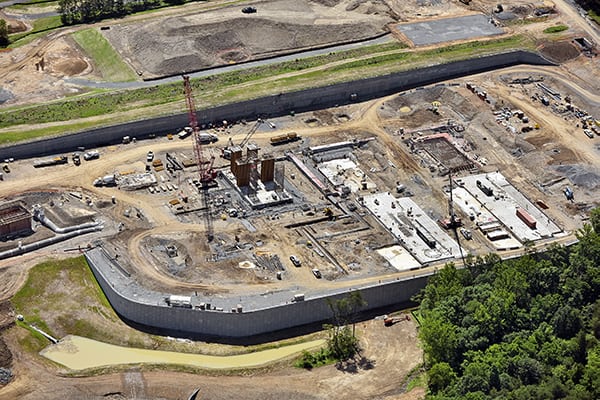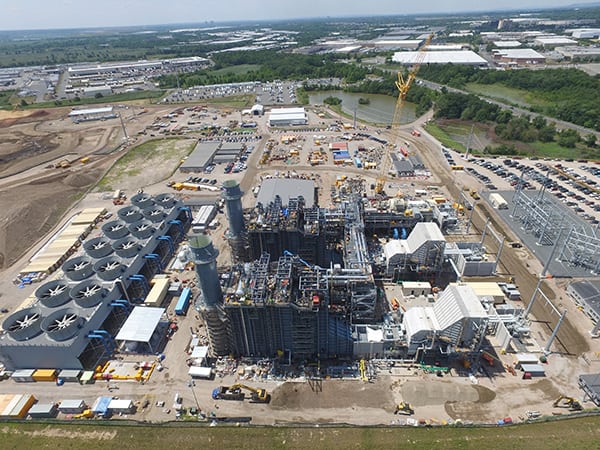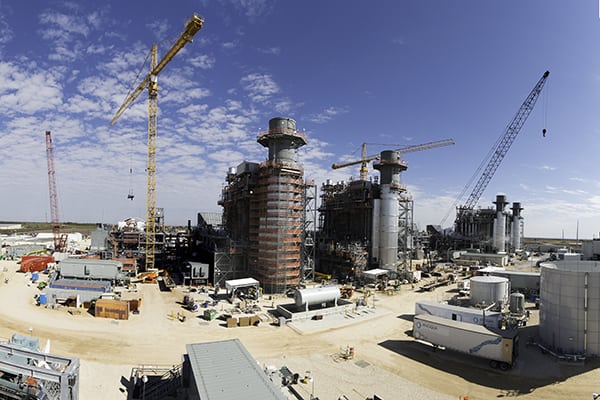Gas-fired power is hot, at least in North America, and quite a few smaller utilities and generators that have never owned a gas turbine plant have begun looking at building one. For large investor-owned companies with plenty of institutional experience in power plant construction, it may be business as usual, but for smaller firms that may have operated only coal-fired plants or small combustion turbines in the past, building a large combined cycle plant carries with it new challenges.
POWER talked to several senior executives with major engineering, procurement, and construction (EPC) firms to get a basic picture of the things to think about when planning a new gas-fired plant.
Where and How?
Scott Osborne, general manager of Bechtel’s power business, emphasized how much there is to think about when beginning the development process.
“Site selection is a key component to a successful project,” he said. “Site location, the approach to makeup and wastewater, access and proximity to key interconnection points such as transmission and gas distribution are all important. Also key is the ability to permit the site (including environmental considerations, local support, proximity to other facilities), and requirements for site work, including civil works, demolition of existing structures and remediation of existing site, if required” (Figure 1).
1. Solid ground. Proper site selection is key to a successful project. Panda Power Fund’s Stonewall plant in Loudoun County, Va., is being built by Bechtel to take advantage of abundant natural gas in the Marcellus region. Courtesy: Panda Power Funds
Dave Flickinger, president of Kiewit Power Group, agreed.
“While there might not be much flexibility in selecting a site, it’s important to factor in how the location impacts a construction project,” he noted. “There are more obstacles in obtaining permits in some areas, which can delay construction. Additional planning and logistics may be required based on the proximity of transmission lines. A readily accessible water supply maximizes efficiency and cost. The growing demand for off-site fabrication requires larger, strategically located shops.”
But the project execution model is one of the first decisions that need to be made, Osborne noted.
“There are also a number of approaches to the execution of the project for customers to consider. The two most prevalent models are the EPC model and the multi-contract model. In the EPC model, one contractor is responsible for the full delivery of the project, a ‘one stop shop.’ In the multi-contract model, the customer typically serves as the overall project manager and manages multiple contracts. Risk assessment and allocation, project financing requirements, project budgeting considerations, and the project management capabilities of the customer’s organization will all factor into the decision on the execution approach for a gas turbine project.”
Jim Hengel, senior vice president and senior project director for Black & Veatch, noted the EPC model tends to be favored by the financing community for large gas plants.
“The EPC method appeals to the financing community because new gas plants will often be built on the basis of nonrecourse financing, so they need to get a lump-sum, fixed-price, fixed-schedule contract,” he said. “That’s normally the method an EPC contractor would employ.”
Flickinger echoed those thoughts.
“The majority of power plant projects today are executed on an EPC basis and generally require an aggressive schedule to meet customer needs, often being engineered, procured, constructed, and commissioned in as little as 28 to 30 months,” he said. “An engineering, procurement, and construction approach offers customers a variety of benefits. Specifically, an EPC contract reduces owner risk, offers cost certainty, shortens project schedules, and results in clearly defined responsibility and accountability roles.”
What Will Power Your Plant?
Another major early decision that must be made is the technology to be used.
“Combustion turbine technology is advancing rapidly in today’s market,” Osborne said. “It’s key for an owner to determine the right fit for the project when considering plant size, site conditions, off-take arrangements, and an assessment of the combustion turbine performance and operating experience.”
“The technology of course is evolving all the time,” Hengel said. “The machines are getting bigger in the combined cycle market, the efficiency is greater, the outputs are greater.” It’s important to pick a contractor with deep experience with gas turbines, he noted. “It’s not really a lot of them playing in that market.”
A plant owner needs to know what will be expected from the plant and choose technology that is best suited for the job.
“Establishing solid performance requirements is critical in selecting the right technology,” Flickinger said. “New and emerging technologies are designed to meet very specific needs, such as base and peak load, emission requirements, water restrictions, and the availability of natural gas. Our team works closely with customers to navigate this process and to ensure they have the right solution in place” (Figure 2).
2. Hot target. Plant owners must have a clear idea of their exact needs to ensure they get a plant that will meet them. This photo shows the Woodbridge Energy Center project in New Jersey, under construction for CPV Shore by Kiewit. Courtesy: Kiewit
Precise Project Scope Is Essential
All three stressed the critical importance of clearly defining what the plant owner expects and when it needs to be done.
“Technology selections and scope selections need to be well thought out and documented for an EPC contractor,” Hengel said. “Describing the scope of services clearly is one of the most important things for establishing fixed-price and fixed-schedule contracts.”
Osborne noted that plant owners need to be active participants in the process, even with EPC contracts where the contractor is handling the bulk of the work.
“Customers who are actively engaged in the project help to ensure a successful outcome for all participants,” Osborne noted. “Working with the contractors, the customer can help set and maintain alignment on key objectives, engage and support the entire project team (customer and contractor) to meet their objectives, and deliver on key customer provided scope and deliverables, such as key project interconnects.”
Flickinger agreed.
“Successful projects are directly correlated to the level of client engagement,” he said. “A collaborative and cohesive team approach yields significant benefits in the form of improved design during the early stages of project execution when precise preparation is most critical. When possible, we co-locate with the customer to create an environment that is conducive to open and transparent communication. We also ensure that all relevant stakeholders are engaged in the project early on, which is imperative to overall project success.”
All those measures will enable the plant owner to better define what the finished plant will look like and be able to do, he said.
“From a cost basis, it’s important that the customer has a solid scope of work incorporated into the contract,” he said. “Any early changes to design or scope have the least economic impact, which is why a good scope document with clear expectations from a design and operability standpoint is key.”
Not being crystal clear on the project scope will lead to trouble later, all noted.
“The worst thing you can probably do is get into a project where things are not well known or well described,” Hengel said.
A healthy dose of realism is also important.
“We have seen a number of new players entering the market with a willingness to sign up for unmanageable pricing and terms,” Flickinger noted. “Consequently, these projects run into issues related to schedule and constructability.”
Develop Realistic Schedules
Getting a comprehensive schedule in place as soon as possible can avoid a lot of problems later, Flickinger said.
“Developing an integrated schedule with engineering, construction, major equipment suppliers and startup/commissioning very early on is critical with respect to schedule and cost. Once a baseline schedule is complete, we evaluate it against a variety of metrics to ensure it is realistic.”
Hengel echoed that sentiment.
“We develop a set of metrics that describes various configurations based on actual performance and experience with how long it takes to do different parts of the project,” he said. “Is it going to be in a winter climate where you cannot do certain things during certain parts of the year? Is it coastal, or in a seismically active area? There’s a long list of things you need to consider.”
Osborne noted that creating the project schedule is not a simple matter.
“First, you need to establish the key drivers, such as desired time to market, to set the overall project objectives. A good grasp on all elements of the project is critical, including major equipment selection, balance-of-plant considerations, and site-specific conditions such as required site work,” he said. “This will enable the proper sequencing of work through the engineering, procurement, construction, and commissioning phases to support project completion.”
This work needs to start before all financing may be in place.
“Developing a strategy with respect to work that may occur in advance of project financial close is another important consideration and should be aligned with the overall project objectives,” Osborne said. “Assess the marketplace for equipment and material lead times to ensure an accurate delivery schedule. A robust assessment of construction labor factors that may influence the project, such as availability of key crafts to support the project schedule, is also key” (Figure 3.)
3. Labor challenges. Building a combined cycle plant requires a wide variety of highly skilled and specialized labor, and the scheduling process must accurately assess who will be available and when. Bechtel completed Panda Power Fund’s Temple 1 plant in Texas two weeks ahead of schedule. Courtesy: Bechtel
Once the schedule is created, it needs to be continually reviewed and managed, Flickinger noted.
“We identify and aggressively manage the scope of primary and secondary critical paths of the project. Our schedules are updated weekly, and the team is strongly encouraged to overreact if they foresee or realize the schedule is slipping.”
Osborne said the same.
“The schedule, in conjunction with the scope of work and execution plan, forms the project baseline for project control purposes. A set of robust tools that provide visibility on how the actual performance compares to the baseline is critical.”
Hengel noted that gas turbine plants differ from other power projects in that the turbines and related equipment are often delivered as part of a larger maintenance and support package from the manufacturer. “The OEMs will determine part of your schedule.”
Avoiding Trouble During Construction
Perhaps the biggest potential source of trouble is in your labor force.
“All these things are dependent on the labor market at the time, both in quantity and quality of labor for the particular region that you are building in,” Hengel said, “so your EPC contractor must have a lot of knowledge about what those markets look like at that particular time. Availability of skilled labor is one of the biggest challenges for keeping on schedule and keeping control of costs.”
Close attention to labor issues is critical because construction demands for combined cycle plants are so high, Flickinger said.
“Gas turbine plant projects require a very specialized, diverse workforce. Since these plants incorporate a variety of components, expertise in each of those components is necessary in order to integrate them properly into the design, construct them effectively, and commission them successfully.”
The EPC contractor must be able to plan ahead to avoid such problems, he said.
“Good plans yield great results. Meticulous planning means we perform the work right the first time, safely and efficiently. We also establish a granular control budget that allows us to foresee or identify overbudget activities quickly. The sooner we identify potential cost or schedule issues, the sooner we can resolve.”
Wrapping It Up
One point Flickinger stressed was that owners and contractors need to be far-sighted and anticipate changes, not just at the project site but with larger issues like changing regulations.
“With the increasingly complex regulatory climate, we find ourselves working with customers in new and different ways, supporting them through regulatory and licensing processes,” he said. “With emerging technologies, there are also challenges with global sourcing, importing components, and ensuring safe and reliable shipping.”
Building a power plant will never be a simple matter, but proper planning and good communication can make the difference between a successful project and one that runs late and over budget.
—Thomas W. Overton, JD is a POWER associate editor (@thomas_overton, @POWERmagazine).













